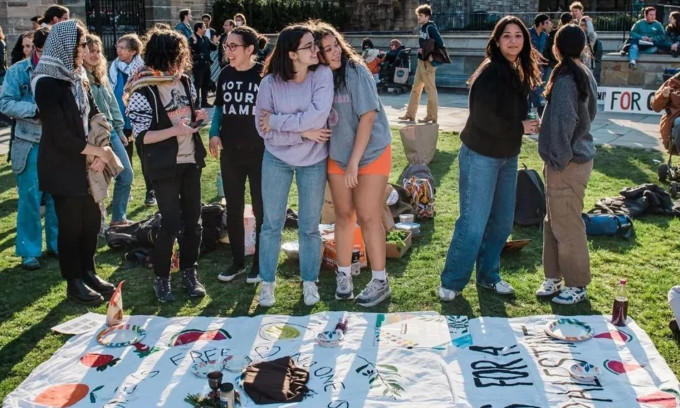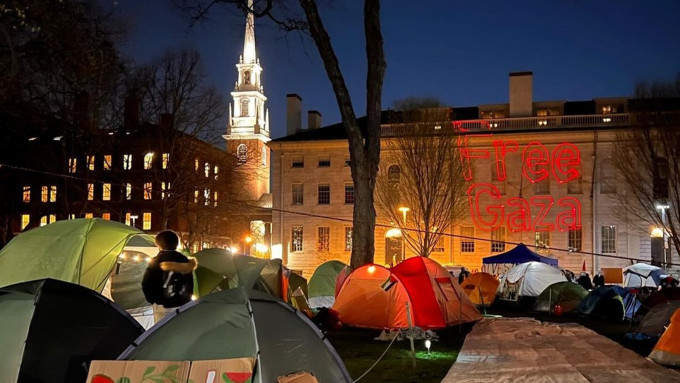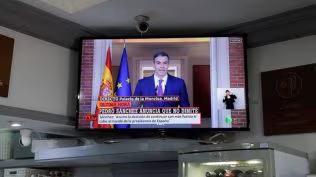Gaza protests: Absurd that universities are funding weapons for mass killings, says Yale student
Students at colleges across the US, including highly respected ones, have been protesting against the Israel-Palestine conflict. Pitching tents, holding candlelight vigils and discussions, cultural performances, and poetry readings, here’s how the students’ protests have shaped up.
As Israel and Hamas remain embroiled in conflict and tensions between Israel and Iran have added fuel to the crisis in the Middle East, thousands of miles away in the US, students are protesting in support of the people in the war-torn Gaza.

From Columbia to Princeton and Austin to Massachusetts, student-led agitations, including Gaza Solidarity Encampments, have swept up campuses after the October 7, 2023, attack by Hamas that left around 1,200 people dead in Israel, and the subsequent Israeli assault on Gaza that has killed more than 34,000 Palestinians.
 For the last six months, students have been getting together to display solidarity for Gaza. (Photo/Instagram/@yalejewsforceasefire)
For the last six months, students have been getting together to display solidarity for Gaza. (Photo/Instagram/@yalejewsforceasefire)
Through the ‘disclose-and-divest’ demands, the students primarily seek transparency in details of funding received from Israel and their subsequent use, apart from boycotting businesses with weapon makers supplying arms and ammunition to Israel and discontinuing acceptance of grants from the Israeli government to fund research projects that aid its military.
“The student community began protesting against the atrocities in Gaza immediately after the October 7 attack and the subsequent retaliation,” Ian Berlin, a senior at Yale University and one of the students currently protesting, told The Indian Express. “We have a chapter called ‘Yale Jews for Ceasefire’ that has been in action for months now,” he added.
Burgeoning protests and varsity stance
In a world of Gen Zs and Alphas where social media is the narrative setter, a quick search on major social media platforms threw up several pro-Palestinian activism organisations of US college students that have been seeking ceasefire and peace.
For the last six months, they have been holding candlelight vigils, phone zaps, in-person meet-ups, and discussion sessions via newsletters and podcasts. Over the past week, attendees at Columbia’s Gaza Solidarity Encampment have organised alternative activities on the lawns, including teach-ins, cultural performances, news updates, analysis sessions, art projects, and poetry readings.
 Yale students held a ‘Passover Seder’ calling on the university to disclose and divest from military weapons manufacturing. (Photo/Instagram/@yalejewsforceasefire)
Yale students held a ‘Passover Seder’ calling on the university to disclose and divest from military weapons manufacturing. (Photo/Instagram/@yalejewsforceasefire)
In New Jersey alone, there are 11 Students for Justice in Palestine chapters across the city. Almost all the Ivy League universities have student bodies dedicated to apartheid and they are all active and engaged for the pro-Palestine cause.
As protests have intensified so has the stance of authorities who have ordered the police to arrest protesters across the US.
But the tipping point was when Columbia University President Minouche Shafik was summoned to testify before the US House Committee on Education and the Workforce on April 17. Amid the hearing, Columbia in Crisis: Columbia University’s Reaction to Antisemitism, doubts were raised about the varsity’s management of antisemitic incidents on the campus amidst the congressional probe into its alleged neglect in safeguarding Jewish students.
“Overnight, the students set up tents ahead of Shafik’s congressional hearing to mount pressure on their demands that Columbia discloses its investments and divests from companies that are profiteering from the war in Gaza,” Anisha Dutta, an independent journalist covering the student protests, told The Indian Express.
The following day, Shafik declared the suspension of protesting students and granted authorisation to New York Police Department officials to evict them. That was on April 18. So far, 900 students have been arrested — with an odd 275 arrests made on Saturday at other campuses such as Indiana University in Bloomington, Arizona State University, and Washington University in St Louis, reported AP.
Questioning universities
Student sit-ins are nothing new for Columbia, or other US universities, and the current encampment dissent models the 1968 anti-war demonstrations urging for the termination of the Vietnam War, protesting against the university’s ties with a Pentagon-associated think tank, and condemning racist policies of the institution.
“It is absurd that educational institutions are funding weapons being used for mass killings,” said Yale’s Berlin, adding that even though it is understandable that changes do not occur overnight, students will continue to protest until their demands are met.
The Harvard Out of Occupied Palestine (HOOP) coalition told The Indian Express it remains committed to occupying Harvard Yard until their demands are met. “Divestment enjoys widespread support in the Harvard community, as evidenced by the long list of over 1,100 signatories, including students, faculty, staff, and alumni, on a letter demanding disclosure of and divestment from Harvard’s investments in the Israeli occupation of Palestine and the ongoing genocide in Gaza,” HOOP said in a statement over email.
 At Harvard, a protester said, “There is no indication that the university is willing to negotiate in good faith”. (Photo/Instagram/@harvxrdpsc/@nouraerak)
At Harvard, a protester said, “There is no indication that the university is willing to negotiate in good faith”. (Photo/Instagram/@harvxrdpsc/@nouraerak)
In the most recent update, student negotiators from the Columbia encampment conveyed that despite meetings held this week, the university had not fulfilled their main request for divestment. However, there was advancement regarding a request for increased transparency in financial disclosures, as per Reuters.
At Harvard, a protester said, “There is no indication that the university is willing to negotiate in good faith”.
The HOOP said the university has threatened students with disciplinary action for participating in the protests and has ramped up police presence and surveillance in and around Harvard Yard. It said in the statement, “The biggest threat to students comes from the administration’s actions and from counter-protestors who have intimidated and harassed students participating in the occupation, their supporters, and onlookers. We ensure student safety by providing access to proper shelter, food, and first-aid, as well as by limiting access to the encampment and by protecting students from harassment by agitators and counter-protestors”.
At Princeton as well, there is no sign of dialogue between the university and the agitators. “My understanding is that there are currently no negotiations going on between the students and the university administration. The university administration has said it sees no reason to speak to the students unless they break university rules,” said Professor Molly Greene, Department of History, Seeger Center for Hellenic Studies, Princeton University.
What US universities are doing now
As protests are underway in more than 17 US universities, students are attending classes. While Columbia has brought in the hybrid model for the ease of students and faculty, it is business as usual at Yale.
In a press briefing, virtually attended by The Indian Express on April 25, Columbia’s Press Office said that given the protests “additional safety and security measures the university has in place include increased patrols strength to provide additional patrols of campus, more personnel for our campus escort service, and more staff at campus access points”.
Ben Chang, VP, Office of Public Affairs, said, “Safety escorts are available to members of the Columbia community at any time of day. There is also enhanced security along the campus perimeter. Campus remains restricted to Columbia University ID holders only with limited gate access. Columbia Public Safety is in close coordination with the NYPD should there be any new developments, the safety and security of our Columbia community and Morningside neighbors are paramount.”
 Some of the faculty members at these universities have steered clear of making any comments, while others have applauded the student endeavours. (Photo/Instagram/@harvardoop/@harvj4p
Some of the faculty members at these universities have steered clear of making any comments, while others have applauded the student endeavours. (Photo/Instagram/@harvardoop/@harvj4p
Providing an update on ongoing discussions with the student protesters, Chang said on April 27, “Starting at the top of the course for several days, a small group of faculty, administrators and university senators have been in dialogue with student organizers to discuss the basis for dismantling the encampment dispersing and following university policies going forward. There’s a formal process underway and it continues… We very much hope these discussions are successful. If they are not, we will have to consider options for restoring conduct on campus”.
An official statement from the university on the same day read, “We called on NYPD to clear an encampment once, but we all share the view, based on discussions within our community and with outside experts, that to bring back the NYPD at this time would be counterproductive, further inflaming what is happening on campus, and drawing thousands to our doorstep who would threaten our community.”
Chang said on April 27, “There is no truth to claims of an impending lockdown or evictions on campus”.
Meanwhile, The University of Texas at Austin and Harvard have suspended the Palestine Solidarity Committee (PSC), one of the biggest non-sectarian student bodies. PSC’s Instagram page called the move “an attack on free speech to distract from and enable Israel’s genocidal campaign against the Palestinian people”.
Some of the faculty members at these universities have steered clear of making any comments, while others have applauded the student endeavours. “I support the protests. I hope that, with these protests taking place across the United States, the Biden Administration will join the rest of the world in calling for an immediate ceasefire, and will stop arms sales to Israel. However, I am not hopeful,” said Princeton’s Greene.
Students like Berlin are hopeful that as vanguards of social radicalism, they can instigate change, at least in their surroundings that happen to be coveted landmarks of academic excellence.
Disclaimer: The copyright of this article belongs to the original author. Reposting this article is solely for the purpose of information dissemination and does not constitute any investment advice. If there is any infringement, please contact us immediately. We will make corrections or deletions as necessary. Thank you.





